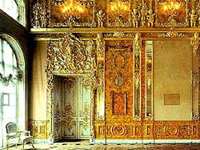|
Arkada Art - the producer of exclusive silver and amber jewelry invite you to visit this web site. The best quality amber jewellery from Poland. Silver and amber jewellery. Modern amber jewellery. Natural Baltic amber jewellery. Wholesale of amber jewelry.
Amber Room
The history of the Amber Room dates back to the very beginning of the 18th century, when Andreas Schluter, the chief architect of the Prussian royal court, had the idea of using amber, a material never before used for interior decoration, to complete one of the rooms of the Great Royal Palace in Berlin during the reconstruction under Frederick I. The works started in 1701 and continued until 1713 with the help of the best German, Swedish, and Dutch amber masters, when the old king died, and the new Prussian King - Frederick Wilhelm I - came into power.
He was not interested in the beautiful and exquisite Amber Room, the rumors of which have by that time reached Russia. The works started in 1701 and continued until 1713 with the help of the best German, Swedish, and Dutch amber masters, when the old king died, and the new Prussian King - Frederick Wilhelm I - came into power.
He was not interested in the beautiful and exquisite Amber Room, the rumors of which have by that time reached Russia.
In 1716, Russian Tsar Peter I visited Berlin, admired the amber masterpiece, and Frederick Wilhelm I asked Peter the Great to accept the unusual room as a diplomatic gift. The Russian Tsar's return present was no less original: 55 choice grenadiers. After a long shipping time and complex route (Berlin-Koenigsburg-Memel-Riga-St.Petersburg) the Amber Room finally reached its destination. The boxes were unpacked but the Russian masters did not manage to reconstruct the Amber Room, and it was for some time forgotten.
When Empress Elizabeth started reigning in the 1740s, she commissioned her chief architect, Bartolomeo Francesco Rastrelli, to use the amber for decoration of one of the rooms of the Winter Palace. The room was too large, and the architect used mirrored pilasters and painted additional panels in "fake amber". In 1755, the Amber Room was transferred to the Catherine Palace in Tsarskoje Selo where the new room was to be constructed.
The room in the Palace was again too large for the Amber Study, and the amber parts were reassembled on the walls alternating with pilasters and mirrors. The places where the amber was missing, were painted in "fake amber" and afterwards replaced with real amber panels. By 1770 the Amber Room was complete. However the amber was damaged by the stove heating and temperature changes, and the room was restored three times: in 1833, 1865, and in the 1890s. The next restoration was to take place in 1941.
In the beginning of WWII it was decided not to evacuate the fragile Amber Room, and instead preserve the treasures on the walls of the Palace disguised by the paper, gauze and cotton. The German troops dismantled the panels and sent them to Koenigsburg, where the Room was displayed in one of the halls of the Koenigsburg Museum. In 1944, as the German Army retired, the Amber Room was dismantled again, and taken into the unknown direction. According to different resources, the Amber Room was:
- destroyed by the Allies' bombing,
- buried in a silver mine not far from Berlin,
- hidden on the shores of the Baltic Sea.
There have been numerous conflicting reports and theories, among them that the Amber Room was destroyed by bombing, hidden in a now-lost subterranean bunker in Konigsberg, buried in mines in a mountain range on the Czech / Polish - German border not far from Berlin, or taken onto a Nazi ship or submarine which was sunk by Soviet forces in the Baltic Sea.
Many different individuals and groups, including a number of different entities from the government of the Soviet Union, have mounted extensive searches for it at various times since the war, with little result. At one point in 1998, two separate teams (one in Germany, the other in Lithuania) announced that they had located the Amber Room, the first in a silver mine, the second buried in a lagoon; neither produced the Amber Room.
However, in 1997 one Italian stone mosaic that was part of a set of four which had decorated the Amber Room did turn up in West Germany, in the possession of the family of a soldier who had helped pack up the Amber Room.
Reconstruction of the Amber Room
 In the early 1980s, serious work on recreating the Amber Room based on old photographs and reminiscences was undertaken in the Catherine Palace, but the lack of funds threatened to put an end to the works.
In the early 1980s, serious work on recreating the Amber Room based on old photographs and reminiscences was undertaken in the Catherine Palace, but the lack of funds threatened to put an end to the works. The process was left to the fate, but it seemed to be merciful to the Amber Room's re-creators. Ruhrgas AG, Essen, Germany, made it possible to reconstruct the legendary Amber Room. As exclusive sponsor, the gas company is provided funds for the continuation of the reconstruction work, and the completion is scheduled for 2003.
Ruhrgas had learned about the project through the newspapers and approached the Tsarskoe Selo Museum about it. The process was left to the fate, but it seemed to be merciful to the Amber Room's re-creators. Ruhrgas AG, Essen, Germany, made it possible to reconstruct the legendary Amber Room. As exclusive sponsor, the gas company is provided funds for the continuation of the reconstruction work, and the completion is scheduled for 2003.
Ruhrgas had learned about the project through the newspapers and approached the Tsarskoe Selo Museum about it.
Arkada Art - exclusive silver and amber jewelry. The best quality amber jewellery from Poland. Silver and amber jewellery. Modern amber jewellery. Natural Baltic amber jewellery.
|
|